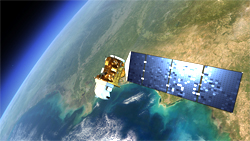Contributor: Patrick Lynch NASA’s Earth Science News Team
 From the first television images of Earth from space, to the now iconic Apollo photographs of Earth, to Voyager’s “pale blue dot,” NASA has changed how we think about exploring Earth and even how we see Earth. Looking back from space provides far more than thought-provoking pictures. NASA’s fleet of Earth-observing satellites orbits our planet multiple times each day, scanning the air, land and seas for critical information about how our planet behaves and how it is changing. Computer-aided visualization of these otherwise invisible reams of data continues to show us radical new ways of looking at Earth.
From the first television images of Earth from space, to the now iconic Apollo photographs of Earth, to Voyager’s “pale blue dot,” NASA has changed how we think about exploring Earth and even how we see Earth. Looking back from space provides far more than thought-provoking pictures. NASA’s fleet of Earth-observing satellites orbits our planet multiple times each day, scanning the air, land and seas for critical information about how our planet behaves and how it is changing. Computer-aided visualization of these otherwise invisible reams of data continues to show us radical new ways of looking at Earth.
To mark Earth Day 2012, we are for the second year in a row inviting you to create your own compelling video vision of NASA’s exploration of Earth — The Home Frontier. Submit your creation to us and a panel of judges will select the best submission, with a fitting award on the line.
The winner will receive behind-the-scenes access to the next rocket launch of a NASA Earth-observing satellite. The Landsat Data Continuity Mission (LDCM), a joint project of NASA and the U.S. Geological Survey, is scheduled to launch from Vandenberg Air Force Base in California in January 2013. LDCM will continue the longest-running satellite record of Earth observations. The first Landsat satellite launched in 1972. The winner of the video contest will get a guaranteed spot on the NASA Social tour and viewing of the launch. These spots are typically chosen by a lottery system.
This contest officially opens for submissions on Earth Day, April 22. Submissions will be accepted until May 31, 2012.
Details:
+ Create NASA Earth Day Video, Win Seats To A Launch

Be Part of What’s Next: Emerging Applications of Landsat at AGU24
Anyone making innovative use of Landsat data to meet societal needs today and during coming decades is encouraged to submit and abstract for the upcoming “Emerging Science Applications of Landsat” session at AGU24.





